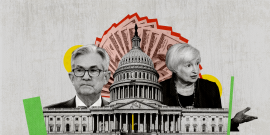Rueff's writings demonstrate the economic and moral indispensability of sound monetary policy for stable long-term growth and basic honesty in policy.
A New Inflationary Era
In this provocative but calmly argued book, The Great Demographic Reversal, Charles Goodhart and Manoj Pradhan predict a new era of widespread and lasting inflation. Goodhart, who has been a respected expert in financial, monetary, and central banking issues for decades, and Pradhan, a macroeconomist who studies global financial markets, express as their “highest conviction view” that “the world will increasingly shift from a deflationary bias to one in which there is a major inflationary bias.”
This conviction reflects their “main thesis” that “demographic and globalization factors were largely responsible for the deflationary pressures of the last three decades, but that such forces are now reversing, so the world’s main economies will, once again, face inflationary pressures over the next three or so, decades.”
The demographic factors include the end of the “positive supply shock” to the global supply of labor provided by China over the previous decades. That is because “China’s working age population has been shrinking, a reflection of its rapidly aging population,” and “the surplus rural labor supply no longer provides a net economic benefit through [internal] migration.” Thus, “China will no longer be a global disinflationary force” and it “no longer stands in the way of global inflation.”
A second key factor is that birth rates around the world continue to decline and longevity to increase, furthering the aging of society and increasing dependency ratios. In this context, the authors point out that the average fertility rate in advanced economies has fallen to well below replacement. This includes the U.S. For the foreseeable future, there will be an ever-lower ratio of active workers to the dependent elderly, with the huge expense of support and health care for the elderly stressing government budgets. They add this striking thought: “Our societies today are still relatively young compared to what is to come.”
These are longer-term, not short-term movements. The implication is that we may envision a slow, great cycling over decades of inflationary and disinflationary or deflationary periods. The 2020s swing to inflation would mark a great cycle reversal, with perhaps a book like The Death of Inflation of 1996 symbolizing the previous reversal.
In a different estimate of the duration of the coming inflationary era, Goodhart and Pradhan make it somewhat shorter: “The coronavirus pandemic… will mark the dividing line between the deflationary forces of the last 30-40 years, and the resurgent inflation of the next two decades.” But whether it’s two or three decades, the authors expect two or three decades, not two or three years, of significantly higher inflation.
The effects of such an inflation would be, they write, “pervasive across finance, health care, pension systems and both monetary and fiscal policies,” and they surely would be. For example, they suggest, “It will no longer be possible to protect the real value of pensions from the ravages of inflation.” Nominal interest rates will be higher, but “Inflation will rise considerably above the level of nominal interest rates that our political masters can tolerate,” so “negative real interest rates… will happen.” Here they should have written, “will continue,” since we already have negative real interest rates, the yield on the 10-year U.S. Treasury note now falling short of the year-over-year inflation rate.
Further, “The excessive debt amongst non-financial corporates and governments will get inflated away.” In other words, governments will implicitly default on their bloated debt through inflation, a classic strategy. Of the three alternatives the book cites for reducing excess debt, “inflation, renegotiation and default,” inflation is the easiest for a government with debt in its own currency.
As the authors say, “neither financial markets nor policymakers are prepared” for such an inflationary future world.
In a final chapter written in 2020, Goodhart and Pradhan conclude that the government deficits and debt created in response to the coronavirus pandemic have reinforced and accelerated the coming inflationary era. Government-mandated quarantines and lock-downs were “a self-imposed [negative] supply shock of immense magnitude.” To finance it, “the authorities quite rightly opened the floodgates of direct fiscal expenditures,” in turn financed by escalating debt and monetization.
“But,” they logically ask, “what then will happen as the lock-down gets lifted and recovery ensues”—as is now well under way—“following a period of massive fiscal and monetary expansion?” To this question, “The answer, as in the aftermaths of many wars, will be a surge in inflation.”
Directionally, I think this is a very good forecast. We are already seeing it play out in the first months of 2021.
How much inflation might there be? They suggest the inflation numbers will be high: “quite likely more than 5%, or even on the order of 10% in 2021.”
Is 5% inflation possible? Well, the U.S. Consumer Price Index rose from December 2020 to April 2021 at the annualized rate of 6.2% when seasonally adjusted, and 7.8% when not seasonally adjusted. Signs of increasing inflation are widespread.
It seems to me that it does fit naturally with the world’s current system of pure fiat currencies, and the burning urge of many politicians to spend and borrow, especially when they are supplied with expansive central bankers. That the official forecasts and public relations statements of those central bankers are so much to the contrary of the theory makes me more inclined to believe it.
How about that 10%? Could we really go to a 10% inflation? It has happened before. The U.S. has been at 10% inflation or more in 1917-20, 1947, 1974, and 1979-81. Most of these followed inflationary financing of wars, but the fiscal deficits and money printing of late are as great as during a war.
The authors proceed to the question of “What will the response of the authorities then be?” and offer this prediction—made in 2020: “First and foremost, they will claim that this a temporary and one-for-all blip.” We already know that this prediction was correct.
Overall, is this theory of a new inflationary era plausible? It seems to me that it does fit naturally with the world’s current system of pure fiat currencies, and the burning urge of many politicians to spend and borrow, especially when they are supplied with expansive central bankers. That the official forecasts and public relations statements of those central bankers are so much to the contrary of the theory makes me more inclined to believe it.
Speaking of the central bankers, Goodhart and Pradhan observe something important: “In recent decades Central Banks have been the best friends of Ministers of Finance [and Secretaries of the Treasury], lowering interest rates to ease fiscal pressures and to stabilize debt service ratios.” But what will happen “when inflationary pressures resume, as we expect”? Will the relationship become more tense or even hostile? To put it another way, might the disputes of 1951 between the U.S. Treasury and the Federal Reserve be re-played and the celebrated “Accord” between them come out in the opposite way: with the central banks more subservient? “Inevitably,” the authors rightly say, “central banks have to be politically agile.”
The book interestingly comments on an implied cycle in the standing of macroeconomics and macroeconomists. How credible are their pronouncements and forecasts? “From the Korean War until about 1973 was a transient golden age for macroeconomics.” The 1960s featured the misplaced confidence of macroeconomists that they could “fine tune the economy,” and control inflation and employment using the “Phillips Curve” they believed in. Sic transit gloria: “It all then went horribly wrong in the 1970s,” when they got runaway inflation and high unemployment combined. And “the second golden period for macroeconomics (1992-2008) [also] went horribly wrong.” That time the announcements of the “Great Moderation,” which central bankers gave themselves credit for, turned into a Great Bubble and collapse. The golden macroeconomic ideas of one era may seem follies to the next.
If the new inflationary era predicted by Goodhart and Pradhan becomes reality, the follies of the present will seem blatant. Should we adopt their “highest conviction” that this inflationary era is on the way? In my view, the economic and financial future is always wrapped in fog, but their argument is well worth pondering and entering into our considerations of the biggest economic risks ahead.



